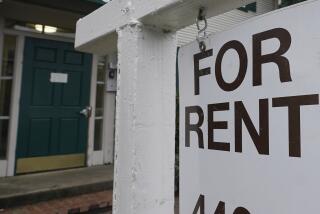2 Studies Find Bias in Rentals
- Share via
Despite being one of the most diverse metropolitan areas in the world, Greater Los Angeles remains a hotbed of racial and ethnic housing discrimination.
Two recent studies of rental practices found that Latino landlords are discriminating against African Americans, and black landlords are discriminating against Latinos, at levels comparable to those practiced by whites against minority groups a decade ago.
Sometimes the discrimination was as blatant as when a Latino apartment manager in the San Fernando Valley peeked out a window, saw an African American would-be renter and wouldn’t let him in.
But much more often the discrimination was subtle. A black apartment manager was not as friendly to a Latino would-be tenant as he was to a less qualified black applicant who was a part of the test.
The government-sponsored studies, based on the largest series of fair housing tests in the Los Angeles area in a decade, found that minority apartment seekers experienced discrimination about 40% of the time and, in a few cases, so did home buyers.
Geographers studying census data have long observed that Los Angeles on a regional basis is quite diverse, lacking a majority of any ethnic group. But when the census data are viewed block by block, segregation patterns are evident.
They show what UCLA geographer William A.V. Clark describes as “striking evidence of persisting own-race selectivity and avoidance of the other races.”
The housing studies tend to confirm this view. In particular, they underscore the existence of housing discrimination in transitional neighborhoods where, for example, Latinos are moving into traditionally black areas. In the city of Los Angeles, the Latino population has grown from about 40% in 1990 to almost 50% now, while the black population has fallen from 13% to about 11% during the same period, according to estimates.
The increasing appearance of more subtle forms of discrimination is in keeping with a 30-year trend. More and more landlords know that turning away prospective tenants because of their race risks lawsuits. State and federal laws prohibit the practice not only because of race or national origin, but also because of religion, age, gender, disability, familial status, marital status or sexual orientation.
Before those laws were passed, blatant discrimination was much more common. Scattered testing data from the 1960s found racial housing discrimination rates in excess of 90%, said UCLA law professor Richard H. Sander, president of the Fair Housing Institute, one of the groups that conducted the two latest studies.
Racial Bias Is Called ‘Pervasive’
The latest studies, consisting of 141 tests, were the largest in the Los Angeles area since the federal government sponsored 300 tests 10 years ago and found a discrimination rate of 30% to 40%. Then, housing discrimination was practiced mainly by white landlords against blacks and Latinos.
Reflecting demographic changes, the latest tests found discrimination between blacks and Latinos.
“It is pervasive and comparable to the worst levels of discrimination practiced by Anglo landlords” in the 1980s, the nonprofit Fair Housing Institute concluded in its report to city government this summer.
Randolph Boyle, executive director of the Fair Housing Congress of Southern California, the other nonprofit organization that performed tests, said similarly: “We found some severe evidence of discrimination, particularly in areas that are transitioning from African American to Latino.”
In the tests, would-be tenants who belong to races or ethnic groups different from that of a landlord ask him about the availability of rentals. These testers are then followed by would-be renters of the landlord’s own race who pretend, for one reason or another, to be less qualified. For example, they pretend to have a weaker credit history. The test is to find out whether the same-race landlord treats them better anyway.
The Fair Housing Congress conducted 45 such tests in the Los Angeles neighborhoods of South-Central, Koreatown, Mar Vista, Venice and the northern San Fernando Valley. It reported finding discrimination in 17 cases. Most of the neighborhoods were selected because they were in the middle of demographic change.
In one San Fernando Valley neighborhood, changing from largely white to largely Latino, several building managers “were able to see tenants before allowing them into the apartment complex,” the congress reported. “In these cases, the African American tester often did not get past the front gate.”
A Latino manager in South-Central said outright that black tenants were undesirable.
An apartment manager in Koreatown, which is seeing an increase in Latino population, refused to help a would-be tenant of another ethnicity by denying that he was the manager.
In addition, some properties had signs in Spanish or Korean--effectively telling would-be tenants who don’t speak those languages to stay away.
Study Looks at Hyde Park
The Fair Housing Institute conducted 96 tests and reported that it found discrimination in 39 of them. Its tests were performed in Hyde Park, a predominantly African American area of the city where Latinos are increasing; in Westchester, a largely white area where more African Americans are moving in; and in Carson and Bellflower, municipalities that contracted for their own surveys.
In Hyde Park, 11 of the 15 Latino testers who asked African American landlords about rentals were met with discrimination, the group said, as well as one of the 10 who persisted and filled out an application. Three of five African American testers who asked Latino landlords about rentals were also discriminated against.
In Carson, which the institute described as “one of the most racially diverse cities in the nation,” three of six African American testers were discriminated against. Two of the four Latino testers also were discriminated against.
In Bellflower, two of four African American testers were told falsely that no units were available, as was one of the two Latino testers.
More to Read
Sign up for Essential California
The most important California stories and recommendations in your inbox every morning.
You may occasionally receive promotional content from the Los Angeles Times.






